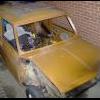this is ours

we decided that it was best to work from the frong to the back, so we set about making the suspension/steering assembly. When my team sat down to discuss what we were going to do about the suspension/steering, we decided that it wouldnt be worth running wishbone suspension due to the complexity of it all, so we have decided to copy the setup used by the kettler pedal cars.

(excuse the dodgey paint drawing :L)

this is currently getting remade with a longer end piece as like u can see, we didnt have any steering lock with the current setup
So the black bit is a C shaped hub as u can see, The red bit is a solid bar that runs across the length of the chassis. the yellow piece is a piece of threaded bar (just what we had to hand) that runs through the hub and the bar, this will allow the hub to turn. the orange bit is going to be a rubber washer to allow alittle bit of absorbation from any bumps or whatever we hit, and the brown bit will be a solid washer to keep the axle where it is. The grey bis is the wheel with the blue bit being the bolt that attaches the wheel to the hub. There will also be a lug welded to the side of the hub to connect the steering rods to to obviously allow us to steer :L
Now after designing that we thaught it would be a good idea to add a spanner to the works in the shape of some ride height adjustment brackets

Now the original plan was to weld these to the chassis, but if we were to do that, we had to be sure that they were welded perfectly straight or it wouldnt work. So instead, we decided to bolt them to the chassis instead


But ofcourse this wasnt without its drawbacks either
Instead of redesigning it all, some clever cloggs (that being me) came up with the idea of adding some triangulation brackets to the height adjusters and then bolt them (or weld them) to the axle, thus decreasing the chances of axle tramp

Whilst all this axle work was going on, another member of the team set about making a steering wheel for the racer, so heres the results of his hard work


So thats about all we have done at the moment and considering we only have 2 and a half hours a week to do stuff and have to share a workshop with young kids, its a good achievement me thinks
Any feedback would be greatly appreciated and noted for use in further manafacture and development
Nick
















